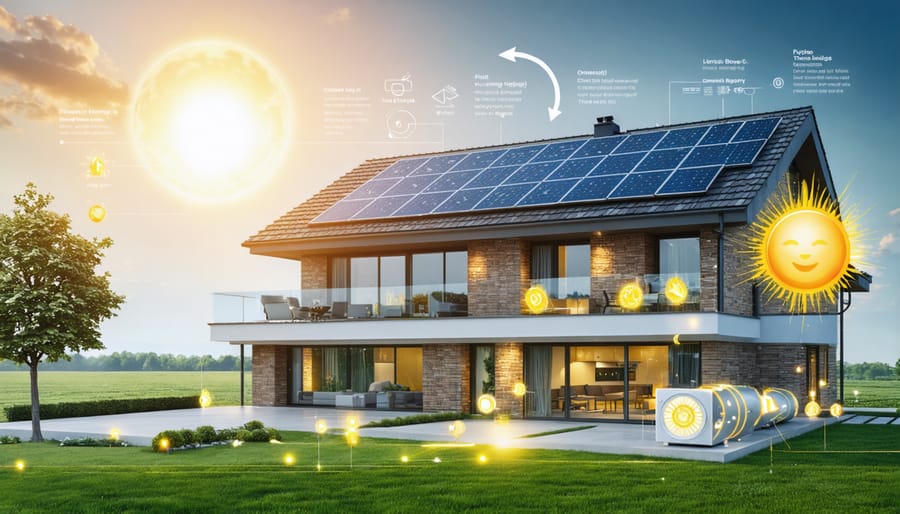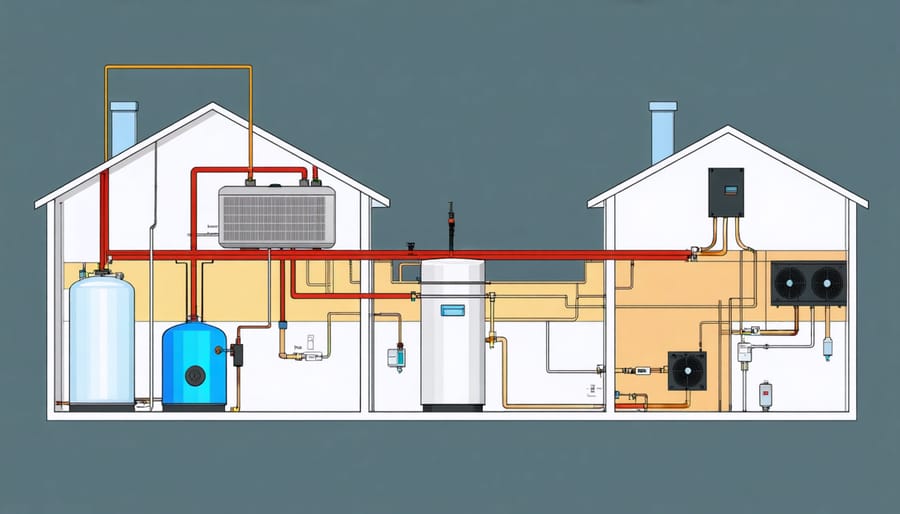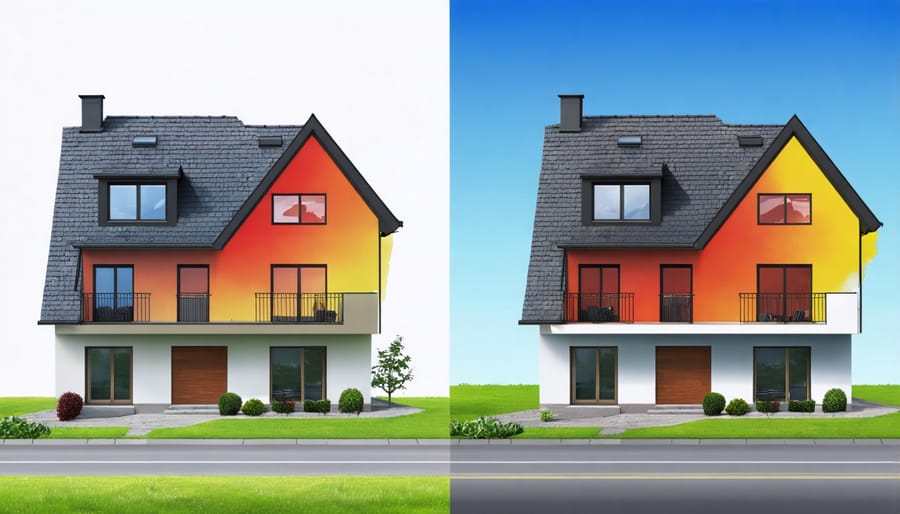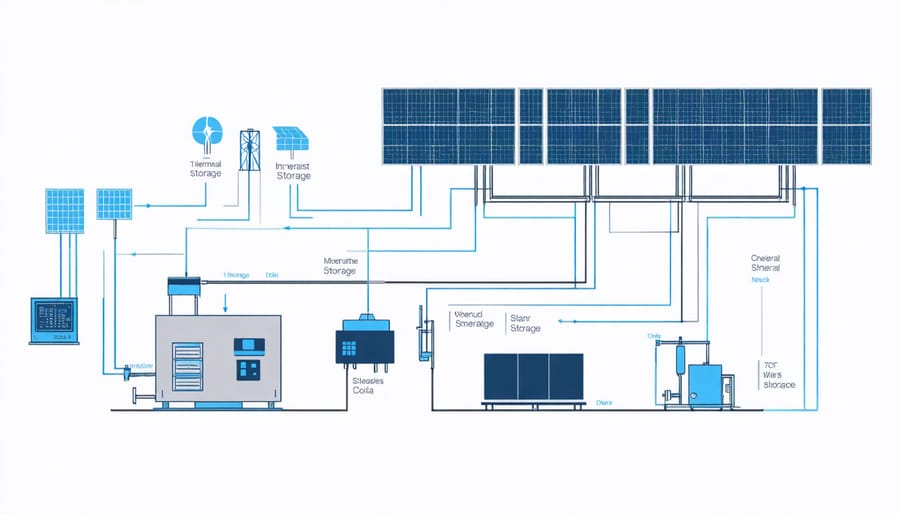Thermal Energy Storage: The Smart Way to Climate-Proof Your Home

Residential thermal energy storage represents a transformative solution in modern home energy management, enabling households to capture and store heat when energy is abundant and release it when needed most. This innovative technology acts as a thermal battery, storing excess solar energy or off-peak electricity in the form of heat, fundamentally changing how we approach residential energy consumption and climate resilience.
As Europe accelerates its transition toward renewable energy, thermal storage systems emerge as a crucial bridge between intermittent renewable sources and consistent household energy demands. These systems can maintain comfortable indoor temperatures while significantly reducing energy bills and carbon emissions. Whether utilizing phase change materials, water tanks, or specialized ceramic bricks, modern thermal storage solutions offer homeowners unprecedented control over their energy usage.
The technology’s relevance has never been more apparent, with climate change driving extreme temperature fluctuations and energy security concerns rising across Europe. For homeowners seeking energy independence and climate adaptation solutions, residential thermal energy storage provides a practical, sustainable pathway to reduce grid dependence while enhancing home comfort and value.
[Word count: 196]
Understanding Residential Thermal Energy Storage
How Thermal Storage Works in Homes
Residential energy storage systems utilize various methods to capture and retain thermal energy for later use. The most common approach involves water-based storage tanks, which efficiently store heat from solar thermal collectors or heat pumps during peak production periods. These systems typically integrate with existing home heating infrastructure, providing warmth for space heating and domestic hot water when needed.
Another effective method employs phase change materials (PCMs), which store and release thermal energy during state transitions. These innovative materials can be integrated into wall panels or floor systems, helping maintain consistent indoor temperatures while reducing heating and cooling demands.
Underground thermal storage, or geothermal heat banking, utilizes the earth’s natural insulating properties. This method involves storing excess heat in underground reservoirs during summer months for winter use, offering exceptional seasonal storage capabilities.
Modern smart control systems optimize these storage solutions by monitoring temperature differences, energy costs, and usage patterns, automatically adjusting operation to maximize efficiency and cost savings while maintaining comfort levels throughout the home.

Types of Residential Storage Systems
Residential thermal energy storage systems come in several forms, each designed to meet specific household needs and energy-saving goals. Water-based systems remain the most common, utilizing insulated tanks to store heated water for both space heating and domestic hot water use. These systems are particularly effective when coupled with solar thermal collectors.
Phase Change Materials (PCMs) represent an innovative storage solution, incorporating specialized materials that absorb and release heat during state changes. These systems are increasingly popular in modern European homes due to their compact size and efficient operation.
Underground thermal storage, including boreholes and aquifer systems, offers significant capacity for seasonal storage, though implementation requires suitable geological conditions. These systems excel at storing summer heat for winter use.
Ice storage systems provide an alternative approach, creating ice during off-peak hours for cooling applications. While less common in residential settings, they’re gaining traction in regions with high cooling demands.
Thermochemical storage, though currently emerging, shows promise for long-term storage with minimal heat loss, using reversible chemical reactions to store and release thermal energy.
Climate Adaptation Benefits

Managing Temperature Extremes
Thermal energy storage systems play a crucial role in managing temperature extremes, offering a robust solution for both summer heat waves and winter cold snaps. During intense summer periods, these systems can absorb excess heat during the day, storing it away from living spaces and releasing it outdoors during cooler nighttime hours. This process significantly reduces the strain on conventional air conditioning systems and helps maintain comfortable indoor temperatures while minimising energy consumption.
In winter months, thermal storage systems work equally effectively but in reverse. They capture and store heat during warmer daytime hours or from auxiliary heating systems, then release this warmth gradually when temperatures drop. This capability is particularly valuable during extended cold periods, ensuring consistent indoor comfort while reducing heating costs and energy demand during peak usage times.
The system’s effectiveness in managing extreme temperatures becomes especially relevant as Europe experiences more frequent climate-related weather events. By acting as a thermal buffer, these storage solutions help stabilise indoor temperatures and reduce the impact of sudden temperature swings. For homeowners, this translates to enhanced comfort, lower energy bills, and reduced dependency on conventional heating and cooling systems during critical weather events. Additionally, the ability to store thermal energy helps balance grid demand during extreme weather, contributing to overall energy system resilience.
Energy Independence and Grid Resilience
Residential thermal energy storage systems play a crucial role in achieving energy resilience and reducing dependence on the traditional power grid. By storing excess energy generated during peak solar production hours, homeowners can maintain a reliable power supply even during grid outages or periods of high demand.
This independence brings multiple advantages for European households. During evening peak hours, when electricity prices typically surge, stored thermal energy can be used for heating and hot water, significantly reducing utility costs. In regions experiencing frequent grid instabilities, thermal storage systems ensure continuous comfort and essential services, regardless of external power supply conditions.
The integration of thermal storage with solar systems creates a robust energy ecosystem within the home. This combination enhances grid stability by reducing peak demand pressure and enables more efficient use of renewable energy resources. During summer months, excess solar energy can be stored for evening cooling needs, while winter storage focuses on heating applications.
Furthermore, this technology contributes to community-wide grid resilience. When multiple households implement thermal storage systems, it creates a network of energy-efficient homes that collectively reduce strain on municipal power infrastructure. This distributed approach to energy management strengthens local power security and supports the broader transition to sustainable energy systems across Europe.
Integration with Solar Systems

Solar-Thermal Synergy
The integration of thermal storage with solar energy systems creates a powerful synergy that maximizes renewable energy utilization in residential settings. When solar panels generate excess electricity during peak sunlight hours, thermal storage systems can capture and store this energy as heat, creating more resilient energy systems for homes.
This combination addresses one of solar energy’s primary challenges: the mismatch between peak generation and peak demand times. During sunny afternoons, when solar production is highest but household energy demand is typically lower, thermal storage systems actively accumulate heat. This stored energy becomes available for use during evening hours or cloudy days, precisely when heating demands increase but solar generation decreases.
The synergy extends beyond simple energy storage. Modern thermal storage solutions can integrate with smart home systems to optimize energy distribution based on weather forecasts and household patterns. This intelligent management ensures maximum efficiency in solar energy utilization while maintaining consistent indoor comfort levels.
For European homeowners, this partnership between solar and thermal technologies offers a sustainable path to energy independence, reduced utility costs, and enhanced climate resilience, making it an increasingly attractive investment for future-focused households.
Smart Control Systems
Modern smart control systems have revolutionized the management of residential thermal energy storage, offering unprecedented efficiency and user convenience. These intelligent systems utilize advanced algorithms and real-time data to optimize energy storage and distribution throughout your home.
By incorporating weather forecasts, electricity pricing signals, and household usage patterns, these systems can automatically determine the best times to store and release thermal energy. They can predict when solar energy production will peak, allowing for strategic pre-heating or pre-cooling of storage systems to maximize renewable energy utilization.
The latest control technologies feature user-friendly interfaces accessible through smartphone apps, enabling homeowners to monitor and adjust their system’s performance remotely. Many systems also integrate with smart home platforms, creating seamless automation between thermal storage and other household systems like ventilation and shading.
These controllers can significantly reduce energy waste by precisely matching storage capacity with anticipated demand. They also provide detailed performance analytics, helping homeowners understand their energy consumption patterns and identify opportunities for further optimization. Some advanced systems even incorporate machine learning capabilities, continuously improving their operation based on historical performance data and user preferences.
Implementation Guide
System Sizing and Selection
Selecting the right thermal energy storage system for your home requires careful consideration of several key factors. The primary determination is your household’s daily energy consumption pattern and heating requirements, which typically range from 10 to 30 kWh per day for an average European home.
For water-based systems, the general rule of thumb is to allocate 50-100 litres of storage capacity per kilowatt of heating demand. A well-insulated 150-square-meter home might require a storage tank between 500-1000 litres, depending on climate zone and heating patterns.
Phase change material (PCM) systems often require less physical space but need precise temperature control. For these systems, calculating the required storage capacity should account for both latent and sensible heat storage capabilities. A typical PCM installation might need 15-25 kg of material per kilowatt-hour of storage capacity.
When selecting system type, consider:
– Available space (basement, utility room, or outdoor area)
– Primary heating source (solar thermal, heat pump, or hybrid systems)
– Local climate conditions
– Building insulation quality
– Peak demand periods
– Budget constraints
Professional assessment is recommended to ensure optimal sizing. This should include thermal load calculations, energy consumption analysis, and evaluation of local renewable energy potential. Regular system monitoring and the possibility of future expansion should also factor into the initial design decisions.
Installation Requirements
Before installing a thermal energy storage system, several key requirements must be considered to ensure optimal performance and compliance with local regulations. The system typically requires a dedicated technical room or basement space of 10-15 square meters, depending on the storage capacity needed. This area should be well-ventilated and waterproof, with adequate drainage facilities.
Structural considerations are crucial, as thermal storage systems can be relatively heavy when fully operational. A standard residential system can weigh between 1,000 to 3,000 kg when filled, requiring proper floor reinforcement and load-bearing capacity assessment. The installation area should also be easily accessible for maintenance and have sufficient clearance for pipe connections and insulation.
Local building regulations and permits vary across European regions, but generally require compliance with safety standards, energy efficiency certifications, and installation by qualified professionals. Many municipalities now offer streamlined permitting processes for renewable energy storage systems, recognising their role in sustainable development.
Additional requirements include proximity to the main heating system, adequate electrical connections for control systems, and proper insulation to minimise heat loss. Some installations may also need modifications to existing plumbing or electrical systems to accommodate the new storage solution.
Cost and ROI Analysis
The financial investment in residential thermal energy storage systems typically ranges from €3,000 to €12,000, depending on system capacity and complexity. Initial costs include storage tanks, heat exchangers, control systems, and professional installation. However, these systems can deliver significant returns through reduced energy bills and increased energy independence.
Homeowners can expect to save 20-40% on annual heating costs, with higher savings achieved when combined with renewable energy sources like solar thermal systems. The payback period usually falls between 5-10 years, influenced by factors such as local energy prices, climate conditions, and available government incentives.
Many European countries offer attractive subsidies and tax benefits for thermal storage installations. For instance, Germany’s federal BAFA grant can cover up to 35% of the installation costs, while France’s MaPrimeRénov programme provides similar financial support.
To maximise ROI, proper system sizing is crucial. An optimally sized system for a typical European household of 4-5 people can reduce peak energy demand by up to 60% and provide annual returns of 8-12% on the initial investment. Additional value comes from increased property value and reduced carbon footprint, making thermal storage a sound long-term investment in sustainable living.
Residential thermal energy storage represents a crucial stepping stone towards achieving Europe’s ambitious climate goals while offering homeowners practical solutions for energy management. As we’ve explored, these systems provide multiple benefits, from reduced energy costs to increased energy independence and improved grid stability.
The technology continues to evolve rapidly, with innovations in phase change materials and smart control systems leading the way. Market trends indicate growing adoption across European households, particularly in regions with strong solar energy potential and supportive policy frameworks. This growth is expected to accelerate as system costs decrease and energy prices continue to rise.
Looking ahead, the integration of artificial intelligence and smart home technologies will further enhance the efficiency and automation of thermal storage systems. We can expect to see more compact designs, improved insulation materials, and better integration with existing heating and cooling infrastructure. The development of community-scale storage solutions also shows promise for maximizing the benefits of thermal energy storage across neighborhoods.
For homeowners considering implementation, the key lies in careful system sizing, professional installation, and regular maintenance. As energy markets evolve and climate challenges intensify, residential thermal storage will increasingly become not just an option but a necessity for sustainable, resilient homes. The investment in these systems today represents a forward-thinking approach to energy management that will pay dividends both environmentally and economically in the years to come.
Leave a Reply